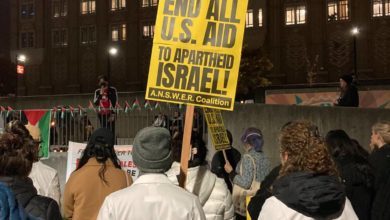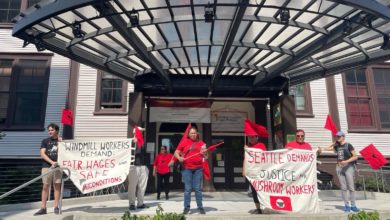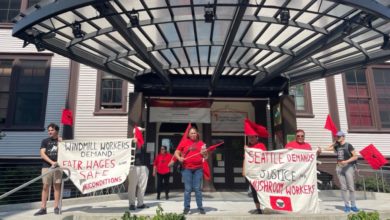One hundred and eight years ago, in the face of racist violence and national oppression, Chinese workers decided to build a new community. The land was rough, but it was cheap, and it was what they could afford. They bought it themselves, pooling together what meager money they had to form investment companies and purchase the land. They surveyed it themselves as well. And brick by brick, Chinese workers built the nucleus of a community-a home- that they would live in and be proud of for many generations to come. Seattle’s Chinatown was soon followed by a Japantown, a Filipino Town, and a Little Saigon. Today, the Chinatown-International District is one of the most multicultural working class neighborhoods in the world. It is a true testament to the undying creative potential of the working class.
To this day, the national character of the workers in this neighborhood is unmistakable, from the signs, to the cuisine, to the cultural activities, to the very languages you hear spoken on the street. It is in this Chinatown-International District that the Cantonese dialect is still a primary language of commerce and daily life, with the vast majority of residents being non-native English speakers. The people are proud of their heritage. Chinese and Vietnamese flags fly from the rafters. Just last month, the Chong Wa Benevolent Association erected a 10-foot tall statue of revolutionary leader Dr. Sun Zhongshan, and all throughout the year cultural festivals fill the streets with joy and pride.
It is still a working class neighborhood. Nearly every resident is a renter, and many of these renters live in socially subsidized housing. The average household income is less than $25,000 a year, less than a third of the city’s median income. Most of those who are not workers are small business owners or self-employed, with over 400 family-owned small businesses in the neighborhood. In the city of Jeff Bezos, Bill Gates,and Paul Allen, it is here in the Chinatown-International District that the worker and the small business owner, whom lawmakers always claim to champion, still persist.
This is not a dying neighborhood. This is a vibrant neighborhood, rich with its history, Asian national character, and proud working class pedigree. So why are some people so eager to destroy it?
Gentrification is a phenomenon throughout all advanced capitalist nations. The United States is no exception. Here in the United States, gentrification takes on a racist character as well as an anti-working class character. Seattle has seen it already- the Central District, which was once a predominantly Black neighborhood, is seeing the displacement of those residents in favor of affluent white newcomers. Rainier Valley too is slowly being wiped out as the forces of gentrification drive ever southward. And now it’s coming to Seattle’s Chinatown-International District. According to the city of Seattle’s own 2035 Report, the CID is the most in danger of displacement of any community in the city today, with at least 16 new private luxury housing projects being planned within the borders of the neighborhood right now.
But, gentrification is not some irreversible force of nature. It is the result of a system, capitalism, and the class that promotes it, the capitalists. There are those in the community, large scale capitalists and small business owners alike, who would like nothing more than to see the class and national character of this neighborhood destroyed by gentrification. In order to fight gentrification, working people and progressive small business owners must fight and unite against those elements of the ruling class outside of their community, as well as those within it.
The CID Coalition
At the heart of the Chinatown-International District’s working class community is a small group of activists. Youth and elders alike, energetic, and primarily anti-capitalist in orientation, these folks meet every week at a local restaurant, bar, or community hub to discuss the issues facing the Chinatown-International District and how to confront them. These passionate people are the Chinatown-International District Coalition, and they are the forefront of this struggle.
Lately, the primary meeting spot, as well as the primary topic of discussion, is Bush Garden, a historic Japanese American owned bar, restaurant, and hub for the community. It is under threat, and after local capitalist James Wong’s purchase of the building, may face displacement if it gets in the way of his plans to build a seventeen story luxury apartment complex on top of it. Despite an outpouring of opposition from the community, Wong and his company Vibrant Cities continue to avoid committing publicly to maintaining the tenancy of Bush Garden or back down from their questionable development proposals.
The CID Coalition has made a name for itself in the community by opposing destructive projects like Wong’s, scoring many victories over its history. Last month, they packed the Bush Asia Center, to give a voice to working members of the community and express their strong opposition to Wong’s disastrous proposals. Going forward, they plan many future actions, with the hopes of mobilizing as many community members as possible to save Bush Garden.
But the struggle is not just about one restaurant. It is an existential one in which every contradiction within the community is laid bare. It is important that socialists continue to follow and analyze this important struggle being waged within the Chinatown-International District, as well as lend full support to the progressive elements within this treasured and historic community.





